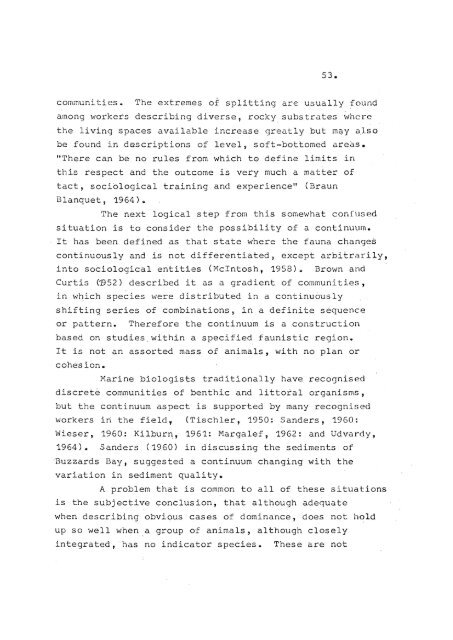The benthic ecology and community structure in Lyttelton Harbour ...
The benthic ecology and community structure in Lyttelton Harbour ...
The benthic ecology and community structure in Lyttelton Harbour ...
You also want an ePaper? Increase the reach of your titles
YUMPU automatically turns print PDFs into web optimized ePapers that Google loves.
53.<br />
communities.<br />
among workers<br />
<strong>The</strong> extremes of splitt<strong>in</strong>g are usually found<br />
crib<strong>in</strong>g diverse, rocky, substrates where<br />
the liv<strong>in</strong>g s available <strong>in</strong>crease greatly but m~y ~lso<br />
be found <strong>in</strong> descriptions of level, soft-bottomed areas.<br />
"<strong>The</strong>re can be no rules from which to def<strong>in</strong>e limits <strong>in</strong><br />
this respect <strong>and</strong> the outcome is very much a matter of<br />
tact, sociological tra<strong>in</strong><strong>in</strong>g <strong>and</strong> experience" (Braun<br />
Blanquet, 1964) ..<br />
<strong>The</strong> next logical step from this somewhat confused<br />
situation is to consider the possibility of a cont<strong>in</strong>uum.<br />
It has been def<strong>in</strong>ed as that state where the fauna changes<br />
cont<strong>in</strong>uously <strong>and</strong> is not differentiated, except arbitrarily,<br />
<strong>in</strong>to sociological entities (McIntosh, 1958)Q Brown <strong>and</strong><br />
Curtis (1152) described it as a gradient of communities,<br />
<strong>in</strong> w~ich spec were distributed <strong>in</strong> a cont<strong>in</strong>uously<br />
shiftio9 s of comb<strong>in</strong>ations, <strong>in</strong> a def<strong>in</strong>ite sequence<br />
or pattern. <strong>The</strong>refore the cont<strong>in</strong>uum is a construction<br />
based on studies, with<strong>in</strong> a specified faunistic region.<br />
It is not an assorted mass of animals, with no plan or<br />
cohesion.<br />
Mar<strong>in</strong>e biologists traditionally have recognised<br />
discret~<br />
communities of <strong>benthic</strong> <strong>and</strong> littotal organisms,<br />
but the cont<strong>in</strong>uum aspect is supported by many recognised<br />
workers iM the field, (Tischler, 1950: S<strong>and</strong>ers, 1960:<br />
Wieser, 1960: Kilbur~, 1961: Margalef, 1962: <strong>and</strong> Udvardy,<br />
1964). S<strong>and</strong>ers (1960) <strong>in</strong> discuss<strong>in</strong>g the sediments of<br />
'Buzzards , suggested a cont<strong>in</strong>uum chang<strong>in</strong>g with the<br />
variation <strong>in</strong> sediment quality.<br />
A problem that is common to all of these situations<br />
is the subjective conclusion, that although adequate<br />
when describ<strong>in</strong>g obvious cases of dom<strong>in</strong>ance, does not hold<br />
up so well when ,a group of animals, although closely<br />
<strong>in</strong>tegrated, has no <strong>in</strong>dicator species. <strong>The</strong>se are not
















